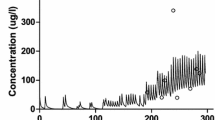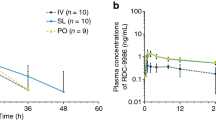Summary
Morphine, morphine-6-glucuronide (M6G), morphine-3-glucuronide (M3G) and normorphine were analysed with high performance liquid chromatography in plasma and urine, collected over 72h after administration of single intravenous 5mg and oral 20mg doses of morphine to 7 healthy volunteers. Systemic plasma clearance of morphine was on average 21.1 ± 3.4 ml/min/kg (1.27 ± 0.20 L/h/kg), volume of distribution was 2.9 ± 0.8 L/kg and oral bioavailability was 29.2 ± 7.2%. Clearance of morphine to form M3G and M6G comprised 57.3% and 10.4%, respectively, and renal clearance comprised 10.9% of total systemic plasma clearance; hence, more than one-fifth of a dose (20.8%) remained as unidentified residual clearance. On the basis of the area under the plasma concentration-time curves determined after oral and intravenous administration, the ratios of M6G: morphine were 3.6 ± 1.2 and 0.7 ± 0.3, respectively. The corresponding figures for M3G: morphine were 29.9 ± 6.8 and 7.7 ± 1.4. Differences in metabolic ratios between the parenteral and oral routes could be attributed solely to differences in morphine concentrations as evidenced both by plasma concentrations and amounts excreted in urine. An oral: parenteral potency ratio of 1: 3 may, thus, be due to differences in circulating amounts of morphine since the proportions of an administered dose found as M6G and M3G after administration by both routes were equal.
A major finding was a slowly declining terminal phase of morphine and metabolites that was evident both in plasma and in urinary excretion versus time curves, where the half-lives of morphine, M3G and M6G were 15.1 ± 6.5h, 11.2 ± 2.7h and 12.9 ± 4.5h, respectively. The terminal half-life of normorphine was 23.9 ± 10.1 h after oral administration. Comparison of oral with intravenous excretion curves showed that a greater part of morphine and metabolites were excreted during the slowly declining phase after the oral dose than the intravenous dose, which is highly suggestive of enterohepatic cycling. The renal clearance of M6G and morphine was seen to exceed creatinine clearance, possibly due to an active secretion process.
Similar content being viewed by others
References
Bodenham A, Quinn K, Park GR. Extrahepatic morphine metabolism in man during the anhepatic phase of orthoptic liver transplantation. British Journal of Anaesthesiology 63: 380–384, 1989
Cone EJ, Welch P, Paul BD, Mitchell JM. Forensic drug testing for opiates: III. Urinary excretion rates of morphine and codeine following codeine administration. Journal of Analytical Toxicology 15: 161–166, 1991
Dahlstrom BE, Paalzow LK. Pharmacokinetic interpretation of the enterohepatic recirculation and first-pass elimination of morphine in the rat. Journal of Pharmacokinetics and Biopharmaceutics 6: 505–519, 1978
Doi R, Inoue K, Kogire M, Sumi S, Takaori K, et al. Simultaneous measurement of hepatic arterial and portal venous flows by transit time ultrasonic volume flowmetry. Surgical and Gynecological Obstetrics 167: 65–69, 1988
Duggan DE, Hooke KE, Noll RM, Kwan KC. Enterohepatic circulation of indomethacin and its role in intestinal irritation. Biochemical Pharmacology 25: 1749–1754, 1975
Gelman S, Dillard E, Bradley EL. Hepatic circulation during surgical stress and anesthesia with halothane, isoflurane or fentanyl. Anesthesia and Analgesia 66: 936–943, 1987
Gong QL, Hedner T, Hedner J, Bjorkman R, Nordberg G. Antinociceptive and ventilatory effects of the morphine metabolites — morphine-6-glucuronide and morphine-3-glucuronide. European Journal of Pharmacology 193: 47–56, 1991
Hanks GW, Hoskin PJ, Aherne GW, Chapman D, Turner P, et al. Enterohepatic circulation of morphine. Lancet 1: 469, 1988
Hanks GW, Hoskin PJ, Aherne GW, Turner P, Poulain P. Explanation for the potency of repeated oral doses of morphine? Lancet 2: 723–724, 1987
Hanks GW, Wand PJ. Enterohepatic circulation of opioid drugs: Is it clinically relevant in the treatment of cancer patients? Clinical Pharmacokinetics, 17: 65–68, 1989
Hanna MH, Peat SJ, Woodham M, Knibb A, Fung C. Analgesic efficacy and CSF pharmacokinetics of intrathecal morphine-6-glucuronide: comparison with morphine. British Journal of Anaesthesiology 64: 547–550, 1990
Hanna MH, Peat SJ, Knibb AA, Fung C. Disposition of morphine-6-glucuronide and morphine in healthy volunteers. British Journal of Anaesthesiology 66: 103–107, 1991
Hasselström J, Alexander N, Bringel C, Svensson JO, Säwe J. Single-dose and steady-state kinetics of morphine and its metabolites in cancer patients — a comparison of two different oral formulations. European Journal of Clinical Pharmacology 40: 585–591, 1991
Hasselström J, Berg U, Lofgren A, Säwe J. Long lasting respiratory depression induced by morphine-6-glucuronide? British Journal of Clinical Pharmacology 27: 515–518, 1989
Hasselström J, Eriksson S, Persson A, Rane A, Svensson JO, et al. The metabolism and bioavailability of morphine in patients with severe liver cirrhosis. British Journal of Clinical Pharmacology 29: 289–297, 1990
Hoskin PJ, Alsayed-Omar O, Hanks GW, Johnston A, Turner P. The influence of blood sample preparation on measured levels of morphine and its major metabolites. Annals of Clinical Biochemistry 26: 182–184, 1989
Jacqz E, Ward S, Johnson R, Schenker S, Gerkens J, et al. Extra-hepatic glucuronidation of morphine in the dog. Drug Metabolism and Disposition 14: 627–630, 1986
Lasagna L, de Kornfeld TJ. Analgesic potency of normorphine in patients with postoperative pain. Journal of Pharmacology 124: 260–263, 1958
Manara L, Bianchetti A. The central and peripheral influences of opioids on gastrointestinal propulsion. Annual Reviews on Pharmacology and Toxicology 25: 249–273, 1985
Mazoit JX, Sandouk P, Sherrmann JM. Pharmacokinetics of unchanged morphine in normal and cirrhotic subjects. Anesthesia and Analgesia 66: 293–298, 1987
Mazoit JX, Sandouk P, Scherrmann JM, Roche A. Extrahepatic metabolism of morphine occurs in humans. Clinical Pharmacology and Therapeutics 48: 613–618, 1990
McQuay HJ, Carroll D, Faura CC, Gavaghan DJ, Hand CW, et al. Oral morphine in cancer pain: influences on morphine and metabolite concentration. Clinical Pharmacology and Therapeutics 48: 236–244, 1990
Olkkola KT, Maunuksela EL, Korpela R, Rosenberg PH. Kinetics and dynamics of postoperative intravenous morphine in children. Clinical Pharmacology and Therapeutics 44: 128–136, 1988
Osborne RJ, Joel SP, Slevin ML. Morphine intoxication in renal failure: the role of morphine-6-glucuronide. British Medical Journal 292: 1548–1549, 1986
Osborne R, Joel S, Trew D, Slevin M. Analgesic activity of morphine-6-glucuronide. Lancet 1: 828, 1988
Osborne R, Joel S, Trew D, Slevin M. Morphine and metabolite behaviour after different routes of morphine administration: demonstration of the importance of the active metabolite morphine-6-glucuronide. Clinical Pharmacology and Therapeutics 47: 12–19, 1990
Owen JA, Sitar DS, Berger L, Brownell L, Duke PC, et al. Age-related morphine kinetics. Clinical Pharmacology and Therapeutics 34: 364–368, 1983
Peat SJ, Hanna MH, Woodham M, Knibb AA, Ponte J. Morphine-6-glucuronide: effects on ventilation in normal volunteers. Pain 45: 101–104, 1991
Plaa GL. The enterohepatic circulation. In Gillette et al. (Eds) Concepts in biochemical pharmacology, Part 3, pp. 130–149, Springer-Verlag, Berlin, 1975
Poulain P, Hoskin PJ, Hanks GW, A-Omar O, Walker VA, et al. Relative availability of controlled release morphine tablets (NST Continus) in cancer patients. British Journal of Anaesthesiology 61: 569–574, 1988
SAS Statistical Package. Statistics, version 5. In SAS User’s Guide, SAS Institute Inc., Cary, North Carolina, 1985
Savarese JJ, Goldenheim PD, Thomas GB, Kaiko RF. Steady-state pharmacokinetics of controlled release oral morphine sulphate in healthy subjects. Clinical Pharmacokinetics 11: 505–510, 1986
Säwe J. High-dose morphine and methadone in cancer patients: clinical pharmacokinetic considerations of oral treatment. Chnical Pharmacokinetics 11: 87–106, 1986a
Säwe J. Morphine and its 3- and 6-glucuronides in plasma and urine during chronic oral administration in cancer patients. In Foley & Inturrisi (Eds) Advances in pain research and therapy, pp. 45–55, Raven Press, New York, 1986b
Säwe J, Dahlstrom B, Paalzow L, Rane A. Morphine kinetics in cancer patients. Clinical Pharmacology and Therapeutics 30: 629–635, 1981
Säwe J, Kager L, Svensson JO, Rane A. Comparison of in vivo and in vitro glucuronidation of morphine in cancer patients. British Journal of Clinical Pharmacology 19: 495–501, 1985
Säwe J, Odar-Cederlof I. Kinetics of morphine in patients with renal failure. European Journal of Clinical Pharmacology 32: 377–382, 1987
Säwe J, Svensson JO, Rane A. Morphine metabolism in cancer patients on increasing oral doses — no evidence for autoinduction or dose-dependence. British Journal of Clinical Pharmacology 16: 85–93, 1983
Shepard TA, Reuning RH, Aarons LJ. Interpretation of area under the curve measurements for drugs subject to enterohepatic cycling. Journal of Pharmaceutical Sciences 74: 227–228, 1985a
Shepard TA, Reuning RH, Aarons LJ. Estimation of area under the curve for drugs subject to enterohepatic cycling. Journal of Pharmacokinetics and Biopharmaceutics 13: 589–608, 1985b
Shimomura K, Kamata O, Ueki S, Ida S, Oguri K, et al. Analgesic effect of morphine glucuronides. Tohuku Journal of Experimental Medicine 105: 45–52, 1971
Sloan PA, Mather LE, McLean CF, Rutten AJ, Nation RL, et al. Physiological disposition of i.v. morphine in sheep. British Journal of Anaesthesiology 67: 378–386, 1991
Smith MT, Watt JA, Cramond T. Morphine-3-glucuronide — a potent antagonist of morphine analgesia. Life Sciences 47: 579–585, 1990
Somogyi AA, Nation RL, Olweny C, Cleary J, Tsirgiotsis P, et al. Plasma concentrations and renal clearances of morphine-6- and morphine-3-glucuronide in cancer patients receiving morphine: VIth World Congress on Pain. Abstract. Pain 5 (Suppl.): S193, 1990
Spector S, Vesell ES. Disposition of morphine in man. Science 174: 421–422, 1971
Svensson JO, Rane A, Säwe J, Sjöqvist F. Determination of morphine, morphine-3-glucuronide and (tentatively) morphine-6-glucuronide in plasma and urine using ion-pair high-performance liquid chromatography. Journal of Chromatography 230: 427–432, 1982
Svensson JO. Determination of morphine, morphine-6-glucuronide and normorphine in plasma and urine with high-performance liquid chromatography and electrochemical detection. Journal of Chromatography 375: 174–178, 1986
Yeh SY. Urinary excretion of morphine and its metabolites in morphine-dependent subjects. Journal of Pharmacology and Experimental Therapeutics 192: 201–210, 1975
Yeh SY, Gorodetsky CW, Krebs HA. Isolation and identification of morphine 3- and 6-glucuronides, morphine 3,6-diglucuronide, morphine 3-ethereal sulphate, normorphine, and normorphine 6-glucuronide as morphine metabolites in humans. Journal of Pharmaceutical Sciences 66: 1288–1293, 1977
Yue QY, Svensson JO, Alm C, Sjöqvist F, Säwe J. Interindividual and interethnic differences in the demethylation and glucuronidation of codeine. British Journal of Clinical Pharmacology 28: 629–637, 1989
Author information
Authors and Affiliations
Rights and permissions
About this article
Cite this article
Hasselström, J., Säwe, J. Morphine Pharmacokinetics and Metabolism in Humans. Clin. Pharmacokinet. 24, 344–354 (1993). https://doi.org/10.2165/00003088-199324040-00007
Published:
Issue Date:
DOI: https://doi.org/10.2165/00003088-199324040-00007




